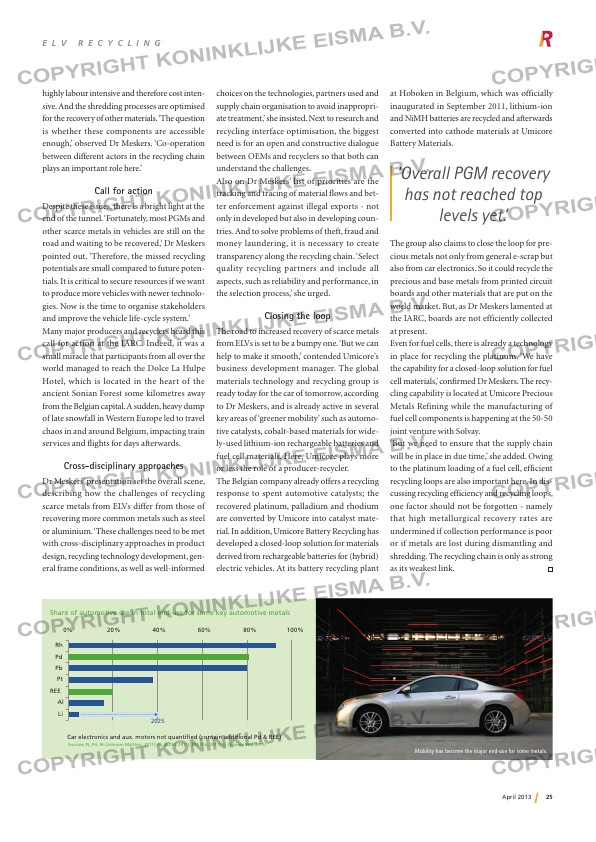Page 25 from: April 2013

25April 2013
E L V r E c y c L i n g
choices on the technologies, partners used and
supply chain organisation to avoid inappropri-
ate treatment,’ she insisted. Next to research and
recycling interface optimisation, the biggest
need is for an open and constructive dialogue
between OEMs and recyclers so that both can
understand the challenges.
Also on Dr Meskers’ list of priorities are the
tracking and tracing of material flows and bet-
ter enforcement against illegal exports – not
only in developed but also in developing coun-
tries. And to solve problems of theft, fraud and
money laundering, it is necessary to create
transparency along the recycling chain. ‘Select
quality recycling partners and include all
aspects, such as reliability and performance, in
the selection process,’ she urged.
Closing the loop
The road to increased recovery of scarce metals
from ELVs is set to be a bumpy one. ‘But we can
help to make it smooth,’ contended Umicore’s
business development manager. The global
materials technology and recycling group is
ready today for the car of tomorrow, according
to Dr Meskers, and is already active in several
key areas of ‘greener mobility’ such as automo-
tive catalysts, cobalt-based materials for wide-
ly-used lithium-ion rechargeable batteries and
fuel cell materials. Here, Umicore plays more
or less the role of a producer-recycler.
The Belgian company already offers a recycling
response to spent automotive catalysts; the
recovered platinum, palladium and rhodium
are converted by Umicore into catalyst mate-
rial. In addition, Umicore Battery Recycling has
developed a closed-loop solution for materials
derived from rechargeable batteries for (hybrid)
electric vehicles. At its battery recycling plant
at Hoboken in Belgium, which was officially
inaugurated in September 2011, lithium-ion
and NiMH batteries are recycled and afterwards
converted into cathode materials at Umicore
Battery Materials.
The group also claims to close the loop for pre-
cious metals not only from general e-scrap but
also from car electronics. So it could recycle the
precious and base metals from printed circuit
boards and other materials that are put on the
world market. But, as Dr Meskers lamented at
the IARC, boards are not efficiently collected
at present.
Even for fuel cells, there is already a technology
in place for recycling the platinum. ‘We have
the capability for a closed-loop solution for fuel
cell materials,’ confirmed Dr Meskers. The recy-
cling capability is located at Umicore Precious
Metals Refining while the manufacturing of
fuel cell components is happening at the 50-50
joint venture with Solvay.
‘But we need to ensure that the supply chain
will be in place in due time,’ she added. Owing
to the platinum loading of a fuel cell, efficient
recycling loops are also important here. In dis-
cussing recycling efficiency and recycling loops,
one factor should not be forgotten – namely
that high metallurgical recovery rates are
undermined if collection performance is poor
or if metals are lost during dismantling and
shredding. The recycling chain is only as strong
as its weakest link.
0% 20% 40% 60% 80% 100%
Rh
Pd
Pb
Pt
REE
Al
Li
Car electronics and aux. motors not quantified (contain additional Pd & REE)
Share of automotive use in total end-use for some key automotive metals
2025
Sources: Pt, Pd, Rh (Johnson Matthey, 2011); Pb (ILZSG, 2011); REE (Du, 2011), Li (Signum Box, 2011)
0
50
100
150
200
250
300
350
1985 1990 1995 2000 2005 2010
Pt Pd Rh PGM recovered
Global automotive catalyst PGM use
and recovery [t/y]
Source: JM
Residues
Residues
Dissipation
Residues
Residues
Historic wastes
(tailings, landfills)
End-of-Life
Product
manufacture
Use
Natural resources
Metals, alloys& compounds
New
scrap
Raw materials production
Recyc
ling
from
industrial
materials
from
Concentrates
& ores
product
reuse
Based on: C.E.M. Meskers:
Coated magnesium, designed for sustainability?
PhD thesis Delft University of Technology, 2008
highly labour intensive and therefore cost inten-
sive. And the shredding processes are optimised
for the recovery of other materials. ‘The question
is whether these components are accessible
enough,’ observed Dr Meskers. ‘Co-operation
between different actors in the recycling chain
plays an important role here.’
Call for action
Despite these issues, there is a bright light at the
end of the tunnel. ‘Fortunately, most PGMs and
other scarce metals in vehicles are still on the
road and waiting to be recovered,’ Dr Meskers
pointed out. ‘Therefore, the missed recycling
potentials are small compared to future poten-
tials. It is critical to secure resources if we want
to produce more vehicles with newer technolo-
gies. Now is the time to organise stakeholders
and improve the vehicle life-cycle system.’
Many major producers and recyclers heard this
call for action at the IARC. Indeed, it was a
small miracle that participants from all over the
world managed to reach the Dolce La Hulpe
Hotel, which is located in the heart of the
ancient Sonian Forest some kilometres away
from the Belgian capital. A sudden, heavy dump
of late snowfall in Western Europe led to travel
chaos in and around Belgium, impacting train
services and flights for days afterwards.
Cross-disciplinary approaches
Dr Meskers’ presentation set the overall scene,
describing how the challenges of recycling
scarce metals from ELVs differ from those of
recovering more common metals such as steel
or aluminium. ‘These challenges need to be met
with cross-disciplinary approaches in product
design, recycling technology development, gen-
eral frame conditions, as well as well-informed
Mobility has become the major end-use for some metals.
‘Overall PGM recovery
has not reached top
levels yet.’
RI-3_Automobile Recycling.indd 25 08-04-13 13:09



